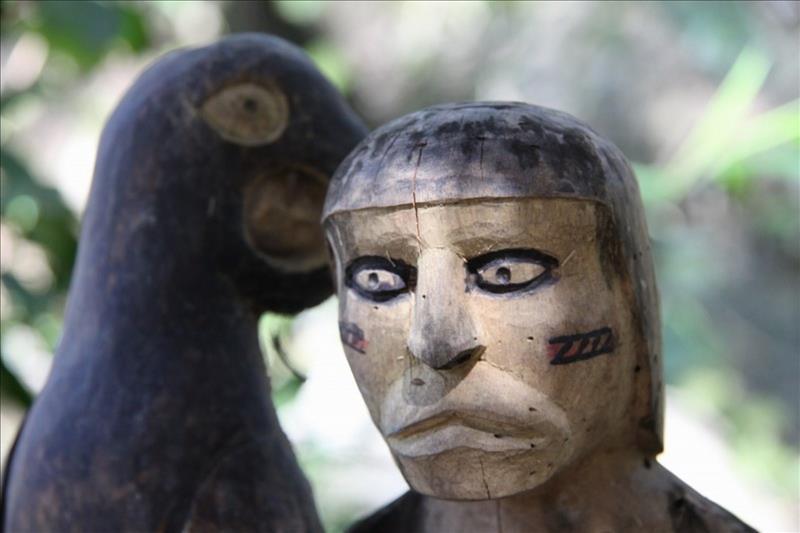Indigenous People in Brazil

The life of the Brazilian natives
Brazil is known for its mixture of peoples and therefore for a great cultural diversity, which motivates many Brazil enthusiasts to travel to Brazil. The Brazilian population is an ethnic mosaic whose origins go back to the mixture of Portuguese colonizers, African slaves, emigrants from Germany, Italy, and Japan, and the Brazilian natives, the Indios. Even today, a large number of ethnic groups of the indigenous people still live in Brazil, although their numbers are in sharp decline. On August 9th, the International Day of the Indigenous Peoples is celebrated worldwide to make humanity aware of their rights and the need to protect these communities living in harmony with nature. The global movement aims to support indigenous peoples in their quest for cultural, ethnic, and social recognition in their own habitat.
According to a list of the socio-ambient institute ISA, more than 230 indigenous peoples are living in Brazil, which in turn are divided into further small communities and belong to 180 different language groups. In 2010, more than 800,000 Brazilian indigenous people were counted, which represents 0.4 percent of the total Brazilian population. According to scientists, about 350,000 live in protected areas. Some of the indigenous peoples consist of less than 40 members and many tribes are threatened with extinction. The Guarani Indians are the largest indigenous people in Brazil with 51,000 members. The census of the Brazilian indigenous people is recorded by the Brazilian Institute of Geography and Statistics (IBGE) and is carried out by various organizations whose mission is the study and protection of the indigenous people of Brazil. The majority of Brazil's indigenous tribes, 60% of them, live in the Amazon region and the states of Acre, Mato Grosso, Tocantins, Amapa, Rondonia, Para, Roraima, and Maranhao, areas where many vacationers stay during their Brazil trip. Almost one-third of the Brazilian indigenous people live in urban centers of Brazil today.
Even before the Europeans discovered South America and the Portuguese colonized Brazil, the Brazilian natives had been living in the fifth largest country in the world for several centuries. Among the first inhabitants of Brazil are the indigenous tribe Kaingang and the Guarani Indians. They look back on a long history and tradition. Their culture has developed from the interaction with the nature surrounding them. Before the Portuguese conquest in 1500, there are estimated to have been five million indigenous people in Brazil. The number of indigenous peoples in Brazil is declining. In the 1960s, the lowest number was reached with 200,000. The majority of Brazil's Indians are in a constant struggle for their land rights and the recognition of their Indian territories (IT). Currently, 674 IT's are counted throughout the country, which are recognized by the Brazilian government. 98.5 percent of the indigenous territories are in the Amazon, although half of Brazil's indigenous people live outside the Amazon. The frequent lack of country regulation leads to conflicts with land speculators, loggers, big landowners, and other invaders.
FUNAI (Fundacao Nacional do Indio), the national authority for the protection of the indigenous population in Brazil, was founded in 1967 by the Brazilian government to advocate for the rights of the Brazilian indigenous people. The indigenous population of Brazil is counted among the government body but also with the support of various national and international NGOs. Brazilian and international Indian protection organizations support the indigenous people in the fight for their land rights and help to secure medical care. They offer protection against infectious diseases when in contact with the rest of the Brazilian population because, for many of the indigenous peoples who live in seclusion in the jungle, the simple flu can have fatal consequences. In the past, entire ethnic groups have been completely wiped out by flu epidemics and measles infections. There are still Indians in the Brazilian jungle who live in seclusion and without any contact with other civilizations and with whom there is no contact with the Brazilian authorities. These are estimated by ethnologists at 46. 12 isolated peoples have been confirmed by FUNAI. A group of the previously isolated indigenous people of Brazil was discovered in northern Brazil at the end of June this year. The tribe was already known to ethnologists, but so far there has been no direct contact with them. At the Envira River, on the border with Peru, the first contacts with the outside world and the encounter with another indigenous tribe, the Ashaninka, were documented. According to Brazilian experts, the group consists of about 50 tribal members. They speak a variant of the Pano languages. The Brazilian Indian authority confirmed that the indigenous people fled from violent attacks from Peru, presumably from loggers. Brazilian scientists are now working to learn more about the living conditions of this tribal community in order to better protect them and their environment.
Brazil now also has ethno-tourism, where travelers can visit indigenous communities during their Brazil vacation and get an insight into their way of life.
Sources: www.brasilienportal.ch; www.tagesspiegel.de; www.welt.de; www.latina-press.com; www.survivalinternational.de

